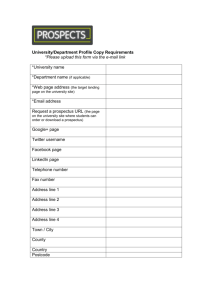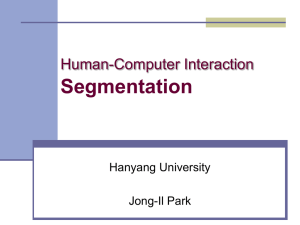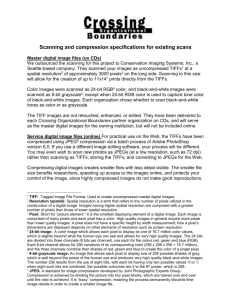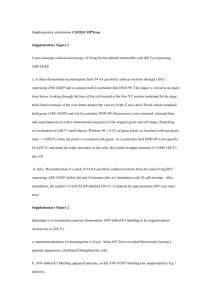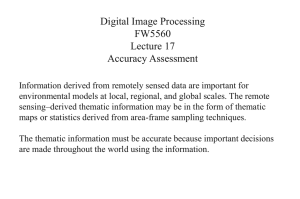wrcr13450-sup-0002
advertisement
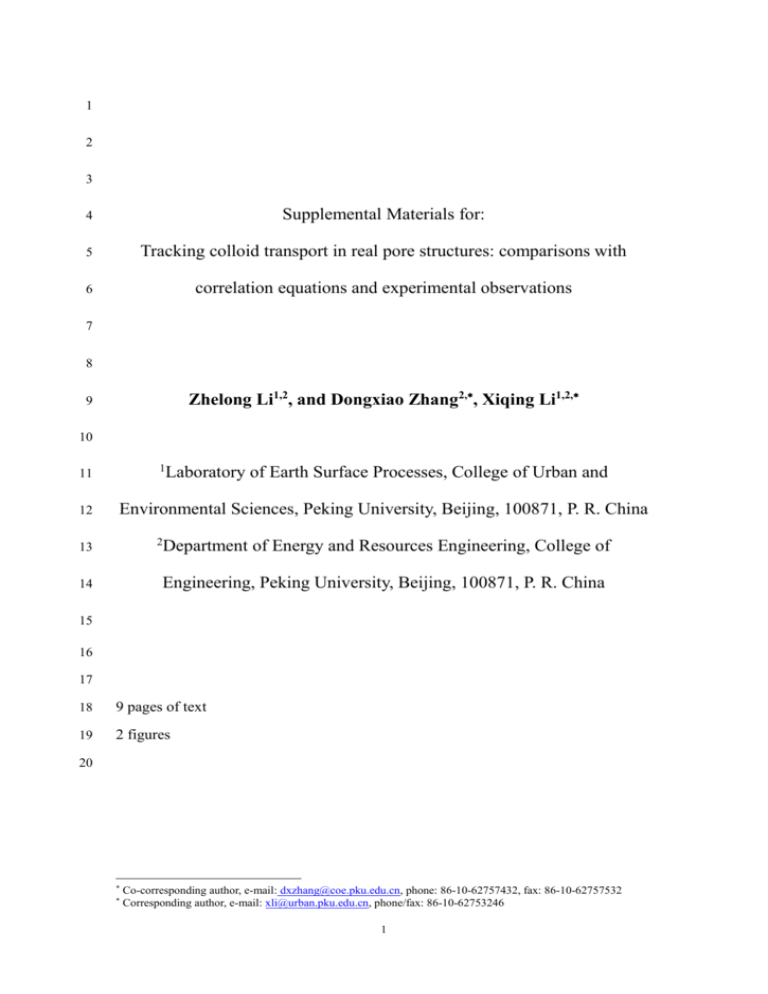
1 2 3 4 Supplemental Materials for: 5 Tracking colloid transport in real pore structures: comparisons with 6 correlation equations and experimental observations 7 8 Zhelong Li1,2, and Dongxiao Zhang2,, Xiqing Li1,2, 9 10 1 11 12 Laboratory of Earth Surface Processes, College of Urban and Environmental Sciences, Peking University, Beijing, 100871, P. R. China 2 13 Department of Energy and Resources Engineering, College of Engineering, Peking University, Beijing, 100871, P. R. China 14 15 16 17 18 9 pages of text 19 2 figures 20 * * Co-corresponding author, e-mail: dxzhang@coe.pku.edu.cn, phone: 86-10-62757432, fax: 86-10-62757532 Corresponding author, e-mail: xli@urban.pku.edu.cn, phone/fax: 86-10-62753246 1 1 Algorithm to extract pore structures from XMT images 2 In this work, an algorithm was developed to automatically extract grain center 3 coordinates and radii from XMT data, which are a set of brightness values at each 4 pixel in three dimensions. For a chosen domain for particle tracking, a domain 5 extending 44 pixels out in each dimension is selected for pore structure extraction. 6 This is done because some grains may partially fall outside the chosen domain but 7 these grains also need to be considered in particle tracking. Manual reading from the 8 XMT images indicates that the maximum grain diameter is no more than 44 pixels. As 9 such, extending 44 pixels out from the chosen domain guarantees that all the grains 10 falling (even if partially) within the chosen domain are extracted. From the XMT data, 11 the pixels that represent solid grains and pore spaces were first assigned with a value 12 of 1 and 0, respectively. The pixels at grain surfaces (solid boundaries) were identified 13 by finding the solid pixels whose 26 neighboring pixels include at least one non-solid 14 pixel. 15 Next, for every solid pixel, the number of solid boundary pixels that fall between 16 the sphere with a radius of r-1 pixels and the sphere with a radius of r+1 pixels (both 17 spheres are centered at the solid pixel) is counted and denoted as Nr. Here r is an 18 integer that ranges from 13 to 22, which are the minimum and maximum number of 19 pixels that a grain radius covers, respectively. A test function is then assigned to the 20 solid pixel and is defined as Nr divided by the volume of a sphere with a radius of r. 21 By incrementing r from 13 to 22, the maximum value (with regard to r) that the test 22 function yields is recorded. If the solid pixel is at the center of a grain, the maximum 2 1 value occurs at an r that is approximately equal to the radius of the grain. If r is very 2 small, the two test spheres would both fall within the grain. The number of boundary 3 pixels falling between the two spheres would be zero. If r is slightly larger than the 4 grain radius, the number of boundary pixels may not be zero, as boundary pixels of 5 the neighboring grains may fall between the two test spheres. However, the number 6 would be much smaller (compared to the case where r is close to the true grain radius), 7 as the test spheres only cut a small portion of the neighboring grains (Figure S1). If r 8 is much larger, the number of boundary pixels falling between the two test spheres 9 could be large. However, the value of the test function that involves a denominator 10 related to r would still be small. For solid pixels that are not at the center of the grain, 11 the maximum test function values would be also small, as the test spheres only 12 encircle a portion of boundary pixels. 13 To identify the solid pixel at the grain center, for each solid pixel with a 14 coordinate of (x, y, z), the maximum test function values within the region of [x-2, 15 x+2] [y-2, y+2] [z-2, z+2] were compared to identify the pixel at which the 16 maximum test function value is the greatest. The solid pixels whose maximum test 17 function values are not locally the greatest are excluded (not recorded). After this step, 18 there may be solid pixels left whose test spheres (at a proper r) contact a number of 19 neighboring grains (Figure S2). In this case, the test spheres could also encircle a 20 significant number of boundary pixels and yield a locally greatest test function value. 21 Therefore, the algorithm counts the number of the non-solid pixels falling within the 22 sphere that is centered at each remaining solid pixel with a radius of r and that yields 3 1 the locally greatest test function value. As illustrated in Figure S1 and Figure S2, for a 2 center pixel, the majority of the pixels falling within the sphere are solid pixels, 3 whereas for a non-center pixel, a significant fraction of the pixels falling within the 4 sphere are non-solid pixels. Thus, a solid pixel with the locally greatest test function 5 value is considered as a non-center pixel and excluded if the ratio of the number of 6 non-solid pixels to the total number of pixels in the sphere is greater than 20%. The 7 remaining solid pixels are all center pixels and their coordinates were recorded. 8 Finally, all the radii that yield the maximum test function values at the center pixels 9 were slightly adjusted by multiplying an identical factor (ranging between 1 and 1.03 10 for different domains) to yield a porosity of the extracted pore structure that is equal 11 to the porosity of the original structure. 12 13 Justification of deriving flow fields at different superficial velocities and for 14 porous media of different grain diameters The flow of an uncompressible fluid is described by the Navier-Stokes equation: 15 16 v 0 17 18 where v is fluid velocity, is density, t is time, p is the pressure, and is viscosity. 19 For steady state flow, the first term of the left side of equation 2 equals zero and can 20 be omitted. According to Happel and Brenner [1974], fluid with a Reynolds number 21 less than 1 can be treated with low Reynolds number hydrodynamics and the second 22 term (which represent the inertial force) of the left side of equation 2 can be neglected. (1) v (v )v p 2 v t (2) 4 1 The highest superficial velocity used in our simulations was 1.36 10-3 m s-1. This 2 velocity corresponds to a maximum Reynolds number of 0.68, assuming a 3 characteristic length of 510 m, which is the maximum average grain diameter 4 encountered in simulations. As such, our simulations all involved low Reynolds 5 number flows that can be described by equation 1 and the following equation: 6 p 2 v (3) 7 For a particular domain, say Domain 1, flow field at a superficial velocity V was 8 obtained by LB simulation by a pressure difference of P1 applied at the inlet and 9 outlet boundary. The flow field derived from LB simulation satisfies the following 10 boundary conditions: 11 v1 x1 , y1 , z1 0 x1 , y1 , z1 S1 (4) 12 p1 x1 , y1 , z1 P1 x1 , y1 , z1 Sin1 (5) 13 p1 x1 , y1 , z1 0 x1 , y1 , z1 Sout1 (6) p1 are the simulated velocity and pressure at ( x1 , y1 , z1 ), 14 where v1 and 15 respectively. S1 is the solid boundary (the bounding x and y planes). Sin1 , Sout1 are the 16 inlet and outlet plane, respectively. 17 For the same domain, the flow field at a superficial velocity of V , that differs 18 , from V1 by a factor of k corresponds to a pressure difference of P1 . The flow field 19 , , (represented by v1 and p1 ) at this superficial velocity should satisfy the following 20 boundary conditions: 21 v1, x1 , y1 , z1 0 x1 , y1 , z1 S1 (7) 22 p1, x1 , y1 , z1 P1, x1 , y1 , z1 Sin1 (8) 5 1 p1, x1 , y1 , z1 0 x1 , y1 , z1 Sout1 2 Assume: 3 P1, v ( x1 , y1 , z1 ) v1 ( x1 , y1 , z1 ) P1 4 , 1 (10) P1, p1 ( x1 , y1 , z1 ) P1 p1, ( x1 , y1 , z1 ) (9) (11) 5 , , Given that v1 and p1 satisfy equation 1, 3, 4, 5, 6, v1 and p1 with expressions 6 in equation 10 and 11 would satisfy equation 1, 3, 7, 8, 9 (this can be easily verified 7 by plugging the two expressions into these equations). Because equation 1 and 3 8 would have a single solution (given the boundary conditions in equation 7, 8, 9) at 9 V1, , the fact that the v1, and p1, in equation 10 and 11 satisfy equation 1 and 3 10 , indicates that the expressions in equation 10 and 11 represent the flow field at V1 . By definition, the two superficial velocities can be expressed as: 11 12 V , v x , y ,z dx dy z1 1 1 1 1 1 (12) A1 v x , y ,z dx dy , z1 1 1 1 1 1 13 V 14 where vz1 and vz1 are the z-direction velocities at ( x1 , y1 , z1 ) at the two superficial 15 velocities; A1 is the area of a cross section of the domain perpendicular to 16 z-direction. Note that the cross section of integration can be randomly picked due to 17 fluid continuity. Plugging the expression in equation 10 into equation 13 yields: 18 V, 19 Hence: (13) A1 , P1, V1 P1 6 1 P1, k P1 2 v1, ( x1 , y1 , z1 ) kv1 ( x1 , y1 , z1 ) 3 Equation 14 verifies that a flow field at a superficial velocity can be derived from the 4 flow field at another superficial velocity by multiplying the ratio of the two velocities. 5 This means that for a particular domain, LB simulation can be performed only once 6 for various superficial velocities. (14) 7 Now, consider a domain (denoted as Domain 2) that is obtained by scaling from 8 Domain 1 by a factor k1. Assuming after scaling a node at ( x1 , y1 , z1 ) in Domain 1 9 yields a node with a coordinate of ( x2 , y2 , z 2 ) in Domain 2, x2 k1 x1 , y2 k1 y1 , 10 and z2 k1 z1 . At an identical superficial velocity V, the flow field in Domain 2 11 (represented by v2 and p2 ) should satisfy following boundary conditions (in 12 addition to equation 1 and 3): 13 v2 x2 , y2 , z2 0, x2 , y2 , z2 S2 (15) 14 p2 x2 , y2 , z2 P2 x2 , y2 , z2 Sin2 (16) 15 p2 x2 , y2 , z2 0 x2 , y2 , z2 Sout 2 (17) 16 where S2 is the solid boundary of Domain 2. Sin 2 , Sout 2 are the inlet and outlet plane, 17 respectively. 18 Assume: 19 v2 ( x2 , y2 , z2 ) k1 20 p2 ( x2 , y2 , z2 ) 21 P2 v1 ( x1 , y1 , z1 ) P1 (18) P2 p1 ( x1 , y1 , z1 ) P1 (19) Given that v1 and p1 satisfy equation 1, 3, 4, 5, 6, v2 and p2 with expressions 7 1 in equation 18 and 19 would satisfy equation 1, 3, 15, 16, 17. This can be verified first 2 by plugging the expressions in equation 18 and 19 into equation 15, 16, 17. Then 3 apply x1 4 19 and plug the resulting expressions into equation 1 and 3. Applying the chain rule of 5 differentiation will verify that equation 1 and 3 are also satisfied. Thus the expressions 6 in equation 18 and 19 represent the flow field in Domain 2. By definition, the 7 superficial velocity in Domain 2 can be expressed as: 8 V 9 where vz 2 is the z-direction velocity at ( x2 , y2 , z 2 ); A2 is the area of the cross 10 x2 v x z2 2 y k1 , 1 z k1 and 1 z2 k1 to the right sides of equation 18 and , y2 ,z2 dx2 dy2 (20) A2 section of integration in Domain 2. Comparing equation 12 and 20 gives: v x , y ,z dx dy z1 1 11 12 y2 1 A1 1 1 1 v x z2 2 , y2 ,z2 dx2 dy2 (21) A2 Since Domain 2 is scaled from Domain 1 by a factor of k1 , 13 A2 k12 A1 (22) 14 dx2 k1 dx1 (23) 15 dy2 k1dy1 (24) 16 Plugging equation 18, 22, 23, 24 into equation 21 yields: 17 k1 18 Thus, equation 18 reduces to: 19 v2 ( x2 , y2 , z2 ) v1 ( x1 , y1 , z1 ) 20 Equation 25 indicates that the corresponding nodes in the two scaled domains have an P2 1 P1 (25) 8 1 identical velocity and LB simulation only needs to be performed in one domain. 2 3 References 4 Happel, J., H. Brenner (1974), Low Reynolds number hydrodynamics: with special 5 applications to particulate media. Noordhoff International Publishing,. 6 9 1 2 3 4 5 Figure S1. Schematic demonstration (in 2-D) of test spheres (pink circles) that encircle the grain surface boundary pixels. The red circles represent test spheres that have too large radii and encircle a smaller number of surface boundary pixels. The green circles are grains. Red dots represent surface boundary pixels. 50 45 4 40 35 3 30 r’+1 25 r-1 r’-1 20 1 r+1 15 10 2 5 0 0 5 10 15 20 25 6 7 8 10 30 35 40 45 50 1 2 3 4 5 Figure S2. Schematic demonstration of test spheres (blue circles) that encircle a significant number of surface boundary pixels (and yield a locally greatest maximum test function value) but whose center is not located at a grain center. 50 45 4 40 35 30 3 r-1 25 r+1 20 1 15 10 2 5 0 0 5 10 15 20 25 6 11 30 35 40 45 50


